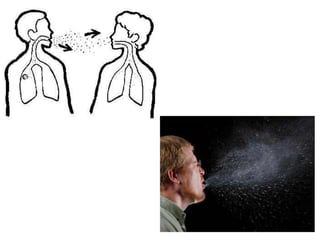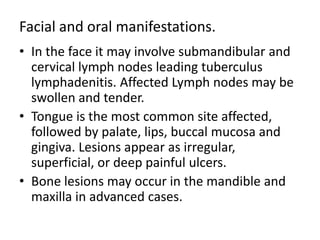Preganacy and Respiratory Diseases in Dentistry
- 1. FRED WAICHERE Moi University School of Dentistry
- 2. PREGNANCY AND DENTISTRY • Pregnancy is not a disease, but a normal state of a woman’s body; however, special treatment is required when the woman is about to undergo dental surgery, so that the developing embryo and the mother herself are not at risk. • The most important risks are noted in the first trimester, because every intervention that may cause hypoxia may have a harmful effect on the embryo or be responsible for spontaneous abortion.
- 4. Questions that a dentist may ask? • Can I take X-rays? • Can I inject local anaesthesia with epinephrine? • What medication can I prescribe? • When should I perform necessary procedures?
- 5. Consideration divided into: • Maternal concerns • Fetal concerns • Radiographic • medication
- 6. 1. Maternal concerns • This arise due to anatomic, physiologic and psychological changes in the pregnant woman Anatomic Supine hypotensive syndrome: due to weight of uterus compressing on inferior vena cava.
- 7. Maternal concerns cont’ • There are also a number of pysiological changes in the body. • GIT = increased gastric acid production, increased esophageal reflux, excessive and uncontrolled vomiting. Avoid morning treatment. • Renal system = increased renal plasma flow, frequency and reduced bladder capacity. Ask patient to void bladder before procedure
- 8. Maternal concerns cont’ • Psychological changes include : fear of pain, disability, death of baby and fear of dental procedures • Hence minimize disturbance, interruption and noise in dental clinic. • Adjust room temperature to minimize irritability • Reassure the patient.
- 9. 2. Fetal concerns First trimester Most critical period of fetal development, with rapid cell division and active organogenesis especially 2nd to 8th week. • Limit dental treatment to periodontal prophylaxis and emergency treament • Avoid routine radiographs. Use selectively when needed.
- 10. Fetal concerns cont’ Second trimester Organogenesis is completed • Safest period for providing dental treatment • Perform elective treatment • Avoid routine radiographs but use selectively when needed. Third trimester There is no risk to fetus in this trimester but the mother may experience increased level of disturbance • Safe to provide dental care in early part of trimester; avoid elective care in second half of trimester. • Use routine radiographs when needed. • Give short dental appointments
- 11. Radiographic concerns Hazards of irradiation to embryo: 1. Death to embryo 2. Birth of deformed child 3. Increased frequency of malignancy 4. Growth retardation 5. Spontaneous abortion (esp in 1st trimester) 6. Mental retardation of child
- 12. Radigraphic concers cont’ Prevention of these complications is done through: • Avoid radiation exposure in 1st timester • Avoid radiation expore in 2nd and 3rd trimester but use selectively if need be, but keep exposure as low as possible. • Always use lead apron • Use long cone and proper collimation • Use fast films • Use extra care when taking radiographs to avoid repeat radiographs.
- 13. Medication concerns • Avoid use of drugs contraindicated in pregnacy. That is FDA class D and X. Analgesics • Eliminate rather than relying on symptomatic relief. • Common analgesics: paracetamol, ibuprofen, oxycodone, codeine. • Asprin may cause maternal and fetal hemorrage and oral clefts, IU death, growth retardation and pulmonary hypotension.
- 14. Medication cont’ Sedatives • Anxiolytics e.g diazepam (rated class D) may cause oral clefts. • Nitrous oxide should not be used in 1st trimester. In 2nd and 3rd trimester use with > 50% oxygen. Antibiotics • Commonly used: penicillin, amoxicillin. Cephalexin, erythromicin base, metronidazole • Avoid : doxycycline, erythromycin (estolate form), vancomycin, tetracycline (FDA: D), chloramphenicol
- 15. Medication cont’ Anaesthesia • LA are not teratogenic; may be administeed in usual dose. • Large dose prilocaine may cause methemoglobinemia hence maternal and fetal hypoxia
- 16. Thank you References • www.slideshare.net/imelhakim/manag-of- pregnant-woman-in-dental-clinic • Textbook of General and Oral surgery , D. Wray et al.
- 17. Respiratory diseases and Dentistry
- 18. Bronchial asthma • Bronchial asthma is a syndrome consisting of dyspnoea, cough, wheezing, that are caused by bronchial spasms. • It can be classified into: intrinsic and extrinsic asthma. Extrinsic – it is the same as allergic asthma, mainly found in children and disappears during adulthood.
- 19. Intrinsic- it is not associated with familial history of allergy and no elevation of IgE in the blood. The onset is usually associated with URTI. Factors that precipitate asthmatic attack. • Airborne substances like pollen and dust. • Drugs e.g. anti-inflammatory and asprin. • Respiratory tract infections.
- 20. Dental management of patients with bronchial asthma. (i) Medical consultation to verify: • Type of asthma and precipitating factors. • Severity and frequency of the attack. • How the attack is usually managed. • Medication taken. (ii) Appointment. • Premedication with diazepam. • Avoid antihistamines, narcotics and asprin.
- 21. (iv) Local anesthesia. • Good pain control is essential as pain may precipitate asthma. (v) Drug used in treatment. • Drug used in the treatment of asthma have major impact in the dental treatment except for prolonged use of corticosteroids (iv) Drugs given to the patient. • Avoid antihistamines , narcotics, asprin and penicillins due to their depressant action on the respiratory system.
- 22. Tuberculosis • Tb is a disease which can affect any organ in the body, however lungs are by far the most affected. • It may be transmitted through airborne droplets of mucus, digestion(secondary form of transmission) Signs and symptoms:- weightloss, productive cough, night sweats, low grade fever.
- 24. Facial and oral manifestations. • In the face it may involve submandibular and cervical lymph nodes leading tuberculus lymphadenitis. Affected Lymph nodes may be swollen and tender. • Tongue is the most common site affected, followed by palate, lips, buccal mucosa and gingiva. Lesions appear as irregular, superficial, or deep painful ulcers. • Bone lesions may occur in the mandible and maxilla in advanced cases.
- 25. Dental management. TB patients can be placed into for categories regarding dental management: (i) Patient with active tuberculosis • Medical consultation. • Patients above 6yrs do only emergency treatment. • Patients below 6yrs treat them as normal patients.
- 26. (ii) Patient with past history of TB. • Medical consultation. • If patient is free from active disease treat as normal but with caution. (iii) Patient with positive tuberculin test. • Medical consultation. • Give isoniazid for prophylactic purposes for up to 1yr. • If free from active disease treat as normal. (iv) Patient with signs and symptoms of TB. • Postpone treatment and refer to physician. • Give only emergency treatment when necessary.
- 27. THANK YOU



























